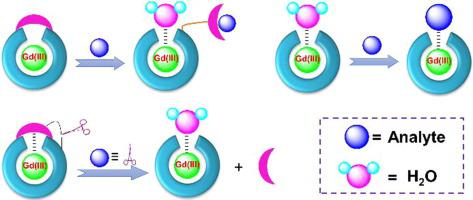Coordination Chemistry Reviews ( IF 20.3 ) Pub Date : 2022-01-25 , DOI: 10.1016/j.ccr.2021.214398 Qingtao Meng 1 , Miaomiao Wu 2 , Zhuye Shang 1 , Zhiqiang Zhang 1 , Run Zhang 2

|
Magnetic resonance imaging (MRI) is a molecular imaging technology that has been widely adopted in biomedical and clinical diagnostics fields owing to its capability of deep tissue imaging with high spatiotemporal resolution. Responsive small molecule MRI contrast agents, known as MRI probes, are of particular interest for the detection and visualisation of target analytes in vitro and in vivo, thus expanding MRI’s capability into the molecular imaging regime. Each of the responsive MRI probe selectively responds to corresponding target analyte and then gives the magnetic resonance (MR) signal change for this analyte detection. In this work, advances in developing responsive MRI probes based on gadolinium(III) (Gd(III)) complexes are systematically summarized. Specifically, we first introduce the strategies in developing Gd(III) complex probes through different response mechanisms, and then discuss the progresses in developing Gd(III) complex-based resposnvie MRI probes for different target analytes, including biologically relevant cations, anions, pH, biomolecules and redox homeostasis. Responsive bimodal probes, such as MRI-fluorescence probes, MRI-PET probes, and MRI-SPECT probes are then briefly outlined. The applications of Gd(III) complex-based responsive probes in in vivo and in vitro MRI are also included. Current limitations and future research directions in developing Gd(III) complex probes for MR analysis and imaging are also proposed. It is anticipated that this work will promote the ongoing research on developing Gd(III) complex-based MRI probes and their applications in understanding the bioactive analytes’ pathophysiological processes.
中文翻译:

响应型钆(III)配合物小分子磁共振成像探针:设计、机理和应用
磁共振成像(MRI)是一种分子成像技术,由于其具有高时空分辨率的深层组织成像能力,已被广泛应用于生物医学和临床诊断领域。响应性小分子 MRI 造影剂,称为 MRI 探针,对于体外和体内目标分析物的检测和可视化特别感兴趣,从而将 MRI 的能力扩展到分子成像领域。每个响应式 MRI 探针选择性地响应相应的目标分析物,然后给出用于该分析物检测的磁共振 (MR) 信号变化。在这项工作中,系统总结了基于钆(III)(Gd(III))配合物开发响应式MRI探针的进展。具体而言,我们首先介绍了通过不同响应机制开发 Gd(III) 络合物探针的策略,然后讨论了针对不同目标分析物(包括生物相关的阳离子、阴离子、pH 值)的基于 Gd(III) 络合物的响应 MRI 探针的开发进展。 ,生物分子和氧化还原稳态。然后简要概述了响应双峰探针,例如 MRI-荧光探针、MRI-PET 探针和 MRI-SPECT 探针。还包括体内和体外MRI。还提出了开发用于 MR 分析和成像的 Gd(III) 复合探针的当前局限性和未来研究方向。预计这项工作将促进正在进行的关于开发基于 Gd(III) 复合物的 MRI 探针的研究及其在了解生物活性分析物的病理生理过程中的应用。






























 京公网安备 11010802027423号
京公网安备 11010802027423号